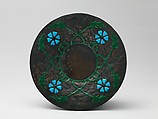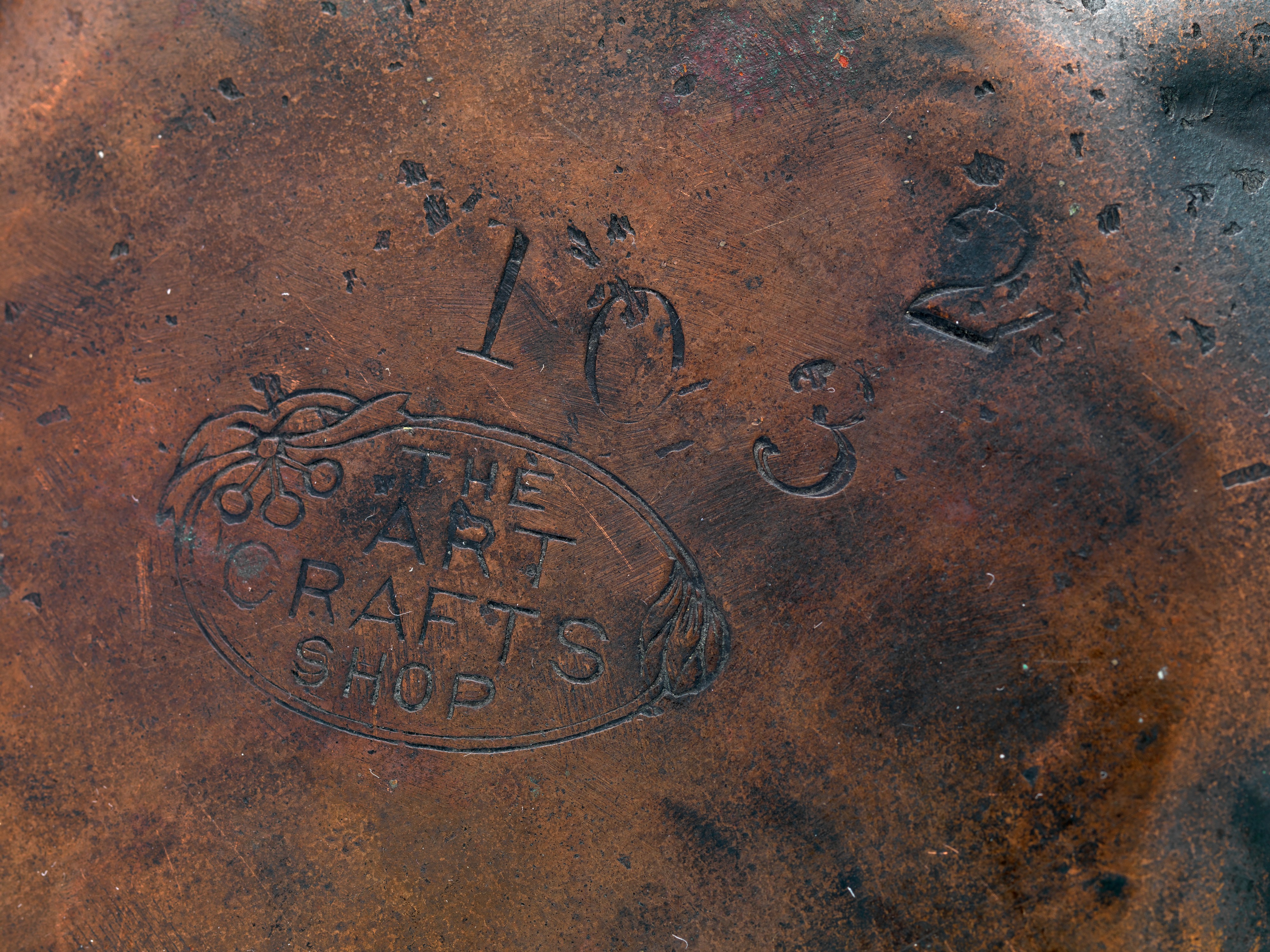Dish
Manufactured by The Art Crafts Shop American
The Art Crafts Shop produced, for a short time, patinated copper dishes, caskets, and desk sets decorated with brightly colored enamel patterns. The shop employed innovative enameling techniques, receiving multiple patents for methods of enamel application. In 1906 they were granted a patent for the technique used on this dish, whereby enamel is applied without a metal framework or webbing.
The Art Crafts Shop was a small, short lived workshop in Buffalo, New York operated by Otto Heintz and Bernard Carpenter. Heintz was a metalsmith, and in the early years of the Art Crafts Shop was involved in his family’s jewelry manufactory, Heintz Brothers. Carpenter was an artist and art teacher in Buffalo who served as the principal designer at the firm. The workshop primarily made dishes, caskets, and desk sets from hammered copper decorated with brightly colored enamel. As its name implies, the shop embraced the style and philosophies of the Arts and Crafts movement, which emphasized the importance handcraftsmanship and the dignity of the craftsperson in an attempt to critique industrialization and mass-manufactured objects. The Arts and Crafts movement advocated uniting form and function; the use, shape, and material dictated how an object was to be ornamented.
The shop’s use of base metal was consistent with the virtues extolled by the Arts and Crafts movement. Unlike silver and gold, copper was a less expensive material often used for everyday metal objects, such as cooking vessels. Consequently, it is perceived to be "simple" and "honest." To endow the plate with the appearance of age and, thus, suggest history, the metal was patinated, a process in which the surface quality of a metal is changed. Patination can either occur naturally from the humidity and particulates in the atmosphere or can be created through the application of certain chemical compounds. The chemical patination employed by The Art Crafts Shop produced a matte, dark brown surface. Although visually effective in achieving the desired color and texture, this artificial patination can result in a degradation of the surface, as is evident on the lower left section of the dish.
The Art Crafts Shop’s work is distinguished not only by its striking matte surfaces but also by the brightly colored applied enamel patterns. Under the aegis of Otto Heintz, the shop used enameling in unique and inventive ways. The shop enameled many items without a metal framework or engraved recesses in the metal. Therefore, the enamel, as can be seen on this dish, sat on the surface of the plate. While this enameling technique created raised, three dimensional graphic patterns, it is less stable than other types of enameled decoration and more prone to chipping. Beyond material expressions of the Arts and Crafts Movement, the patterns produced by enamellers at The Art Crafts Shop reflect the stylistic and aesthetic ideals of the movement. The flowers, stems, and leaves depicted are simplified, conventionalized forms—natural elements conveyed as abstracted pattern. This stylized interpretation of nature is heir to the English design reform movement of the nineteenth century, which encouraged artisans to create harmony between the function of their objects and the simplified ornamentation used to decorate them. This dish embodies such harmony; rather than overpower, the conventionalized ornamentation compliments the circular form. Here, highly naturalistic or complex ornamentation would distract both from this shape and soft patinated copper surface.
Sometime in 1906 Otto Heintz renamed the firm Heintz Art Metal Shop. With this shift in title came a significant change in the appearance of the objects produced and materials used by the shop. Heintz’s focus on enameling shifted to an interest in applied silver decoration, perhaps reflecting his origins as a jeweler. Copper objects decorated with brightly colored enamel are, therefore, rare, having only been produced between 1902 and 1906. They represent a small, yet inventive, expression of the American Arts and Crafts movement.
This image cannot be enlarged, viewed at full screen, or downloaded.
This artwork is meant to be viewed from right to left. Scroll left to view more.



